
Sternhalma, commonly known as Chinese checkers or Chinese chequers, is a strategy board game of German origin that can be played by two, three, four, or six people, playing individually or with partners. The game is a modern and simplified variation of the game Halma. "Complexity: requires no counting or spelling; even young children can play."

Twister is a game of physical skill produced by Milton Bradley Company and Winning Moves Games USA. It is played on a large plastic mat that is spread on the floor or ground. The mat has four rows of six large colored circles on it with a different color in each row: red, yellow, green and blue. A spinner tells players where they have to place their hand or foot. The game promotes itself as "the game that ties you up in knots".
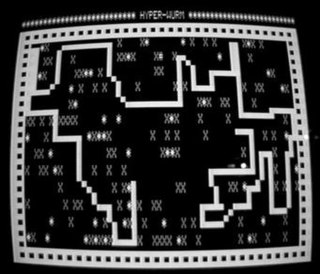
Snake is a sub-genre of action video games where the player maneuvers the end of a growing line, often themed as a snake. The player must keep the snake from colliding with both other obstacles and itself, which gets harder as the snake lengthens. It originated in the 1976 two-player arcade video game Blockade from Gremlin Industries where the goal is to survive longer than the other player. The concept evolved into a single-player variant where a snake gets longer with each piece of food eaten—often apples or eggs. The simplicity and low technical requirements of snake games have resulted in hundreds of versions—some of which have the word snake or worm in the title—for many platforms.

Parchís is a Spanish board game of the original from the Dominican and republic Cross and Circle family. It is an adaptation of the Indian game Pachisi. Parchís was a very popular game in Spain at one point as well as in Europe and north Morocco - specifically Tangiers and Tetouan, and it is still popular especially among adults and seniors. Since it uses dice, Parchís is not usually regarded as an abstract strategy game like checkers or chess. It does not depend entirely on luck either, since the four pawns under a player's command demand some sort of strategy.

ZÈRTZ is the third game in the GIPF Project of seven abstract strategy games. The game features a shrinking board and an object that promotes sacrifice combinations. It is impartial: since neither player owns on-board pieces, maintaining the initiative is of fundamental importance.
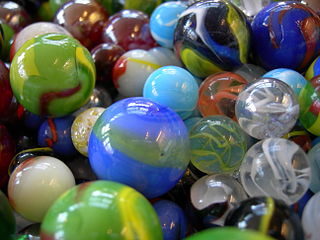
A marble is a small spherical object often made from glass, clay, steel, plastic, or agate. They vary in size, and most commonly are about 13 mm in diameter. These toys can be used for a variety of games called marbles, as well being placed in marble runs or races, or created as a form of art. They are often collected, both for nostalgia and for their aesthetic colors.
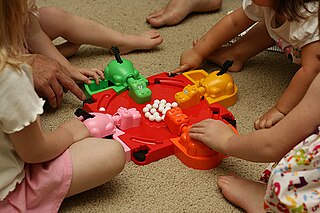
Hungry Hungry Hippos is a tabletop game made for 2–4 players, produced by Hasbro, under the brand of its subsidiary, Milton Bradley. The idea for the game was published in 1967 by toy inventor Fred Kroll and it was introduced in 1978. The objective of the game is for each player to collect as many marbles as possible with their "hippo". The game is marketed under the "Elefun and Friends" banner, along with Elefun, Mouse Trap and Gator Golf.
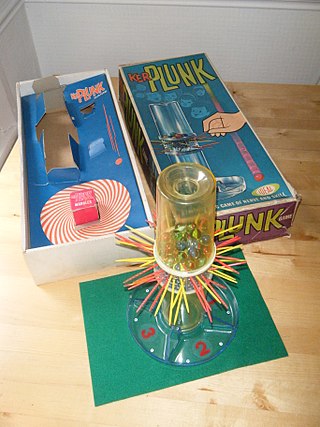
KerPlunk is a children's game invented by Eddy Goldfarb with Rene Soriano and first marketed by the Ideal Toy Company in 1967. The game consists of a transparent plastic tube, plastic rods called straws and several dozen marbles. The base contains four separate numbered trays and the straws are passed through holes in the middle of the tube to form a lattice. The marbles are then placed in the top of the tube and held in place by the lattice. The onomatopoeic name of the game derives from the sound of the marbles tumbling to the base of the tube during play.

Euchloe ausonides, the large marble or creamy marblewing, is a species of butterfly that occurs in western North America. It lays eggs on the terminal flower buds of a variety of plants in the mustard family, including introduced Eurasian species, and the larvae feed on the buds, flowers and fruit of these plants. In California, it has witnessed population declines since the 1980s, especially in the Central Valley and the Bay Area, and in Washington, its subspecies the island marble butterfly is a candidate for listing under the Endangered Species Act.
Fireball Island is a board game first published by Milton Bradley in 1986. The tagline is "The dimensional adventure game of pitfalls and perils!" It is set on an unexploited tropical island, the home of the ancient idol Vul-Kar. Players progress along winding paths around the island, avoiding fireballs and trying to steal Vul-Kar's jewel and carry it to the escape boat. The game concept was originally developed by artist / toy designers Bruce Lund and Chuck Kennedy. The game was licensed to Milton Bradley by Anjar Co., an international toy licensing company and co-licensor of the game.

Pentago is a two-player abstract strategy game invented by Tomas Flodén.
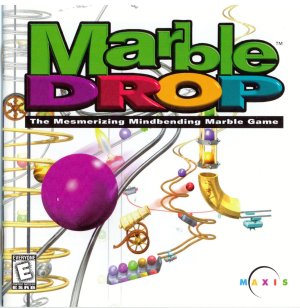
Marble Drop is a puzzle video game published by Maxis on February 28, 1997.

Mall Madness is a shopping themed board game released by Milton Bradley in 1988.
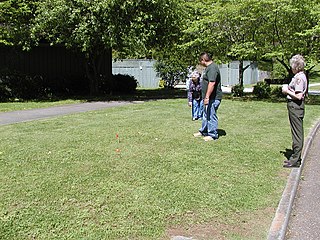
Cherokee marbles, or five hole is a traditional game among the Cherokee people of the United States, in which players roll small stone balls between five shallow pits dug into a playing field. Today, the game is commonly played with billiard balls. The game may be played in individual or team play, and in this century, has been introduced into the curricula of students attending schools in the Cherokee Nation. There is also a national tournament held annually during the Cherokee National Holiday.

Bradley's Toy Money Complete with Game Of Banking was produced by the Milton Bradley Company.

Four Field Kono is an abstract strategy game from Korea. Each player attempts to capture the other player's pieces by jumping over their own piece and landing on the other player's piece. The game is not related or similar to another Korean game called Five Field Kono.

Schaper Toys, or W.H. Schaper Mfg. Co., Inc. as it was originally known, was a game and toy company founded in 1949 by William Herbert Schaper in Robbinsdale, Minnesota. "Herb" Schaper published a variety of games but was best known for having created the children's game, Cootie. In 1971, the company was sold to Kusan, Inc., and began operating as Schaper Toys, a subsidiary of Kusan, Inc. In 1986, Schaper Toys was acquired by Tyco Toys, which sold the rights to Cootie and three other of the company's best-known games to the Milton Bradley Company. These games are still being sold.

Stay Alive is a strategy game, where 2-4 players try to keep their marbles from falling through holes in the game board while trying to make their opponents' marbles fall through. It was originally published by Milton Bradley in 1971 and marketed in television and print advertising as "the ultimate survival game". Stay Alive was republished with a smaller board by Winning Moves Games USA in 2005. This game is no longer in production.

Avalanche, also marketed as Lawine in the Netherlands, Avalancha in Spain, and Astroslide or Skill in Germany, is an abstract, mechanical strategy game published by Parker Brothers in 1966 that features colored marbles that roll down an inclined board.

Luxor Evolved is a tile-matching video game released in 2012 by MumboJumbo.
















